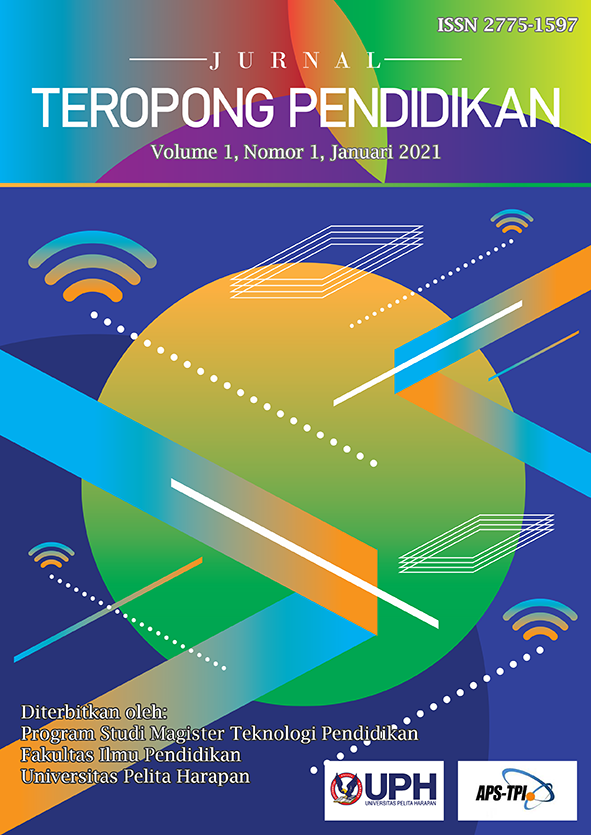PENERAPAN DIALOGUE JOURNALS PADA PEMBELAJARAN MENULIS BAHASA INGGRIS UNTUK MENINGKATKAN MOTIVASI MENULIS DAN KETERAMPILAN MENULIS SISWA ENGLISH AS ADDITIONAL LANGUAGE (EAL) KELAS 4 DI AUSTRALIAN INDEPENDENT SCHOOL (AIS) [THE IMPLEMENTATION OF DIALOGUE JOURNALS IN ENGLISH WRITING LEARNING TO INCREASE THE WRITING MOTIVATION AND WRITING SKILLS OF GRADE 4 ENGLISH AS ADDITIONAL LANGUAGE (EAL) STUDENTS AT AN AUSTRALIAN INDEPENDENT SCHOOL (AIS)]
DOI:
https://doi.org/10.19166/jtp.v1i1.3129Keywords:
EAL Students, Dialogue Journals, Motivation in Writing, Writing SkillsAbstract
Writing in English takes place intensively but students’ writing motivation was low and their writing improvement didn’t meet the expectation. This situation raised concerns which led to improvement planning that aimed to 1) describe the implementation process of Dialogue Journals, 2) analyze the development of students’ writing motivation, 3) analyze the development of students’ writing skills, and 4) identify obstacles faced during the process of implementation and solutions to overcome them. This research used a classroom action research which consisted of three cycles and was conducted at Australian Independent School with six grade 4 EAL students involved. Resources of data collection were based on class observation, study of documentation, and measurement of students’ writing motivation and writing skills using writing motivation and writing rubric. The results of the research showed that 1) Dialogue Journals were applied based of suggestive steps and plans, 2) 5 out of 6 students’ writing motivation raised , 3) 5 out 6 students’ writing skills improved, 4) obstacles had been identified which included students’ absence, emotional, and behavioural problems which needed immediate solution, and teacher time management to reply to students, and learning tool availability and access. Solutions to the related obstacles were arranged and applied.
BAHASA INDONESIA ABSTRACT: Kegiatan menulis bahasa Inggris siswa EAL kelas 4 berlangsung secara intensif namun motivasi menulis siswa rendah dan perkembangan keterampilan menulis siswa tidak sesuai harapan. Kondisi ini merisaukan. Bermula dari kerisauan ini, guru melakukan tindakan perbaikan dengan penerapan Dialogue Journals yang bertujuan: 1) mendeskripsikan proses penerapan Dialogue Journals, 2) menganalisis perkembangan motivasi menulis bahasa Inggris, 3) menganalisis perkembangan keterampilan menulis bahasa Inggris, dan 4) mengidentifikasi kendala yang dihadapi selama proses penerapan berlangsung dan solusinya. Penelitian ini menggunakan Penelitian Tindakan Kelas (PTK). Penelitian dilaksanakan dalam tiga siklus di Australian Independent School (AIS). Subyek penelitian terdiri dari enam orang siswa dan siswi kelas 4. Pengumpulan data dilakukan melalui observasi, studi dokumentasi dan penilaian dengan menggunakan rubrik, serta dianalisis secara kualitatif deskriptif. Hasil penelitian menunjukkan: 1) penerapan Dialogue Journals sesuai dengan langkah-langkah yang disarankan dan direncanakan, 2) motivasi menulis 5 dari 6 orang siswa meningkat, 3) keterampilan menulis 5 dari 6 siswa meningkat dan 4) kendala dalam proses penerapan diantaranya ketidakhadiran siswa, masalah sikap yang timbul yang perlu penanganan segera, manajemen waktu guru, penggunaan dan ketersediaan fasilitas alat bantu. Solusi berupa penyediaan strategi manajemen emosi dan sikap, mengatur waktu dan mendorong siswa belajar secara mandiri.
References
Australian Curriculum. (n.d.). Who are EAL/D students? Retrieved April 8, 2015, from http://www.australiancurriculum.edu.au/studentdiversity/who-are-eal-d-students
Australian Curriculum, Assessments and Reporting Authority. (2014, February). English as an additional language or dialect: Teacher resource EAL/D learning progression. http://www.acara.edu.au/verve/_resources/student_illustrations_of_the_eald_learning_progression_revised_february_2014.pdf
Budden, J. (2008). Error correction. Teaching English. https://www.teachingenglish.org.uk/article/error-correction
Corpuz, V. A. F. S. (2011). Error correction in second language writing: Teachers’ beliefs, practices, and students’ preferences. [Master thesis, Queensland University of Technology]. http://eprints.qut.edu.au/49160/1/Victor_Corpuz_Thesis.pdf
Daztman, K. (n.d.). Using dialogue journals to improve writing for English language learners. http://www.arareading.org/Resources/Documents/The%20Reader/Kaitlyn_Datzman_Second_Language_Writing_Action_Research.pdf
Denne-Bolton, S. (2013). The dialogue journal: A tool for building better writers. English Teaching Forum 51(2), 2-11. https://eric.ed.gov/?id=EJ1018770
ESL Developmental Contininuum P-10. (2008). Teaching strategy - Using the curriculum cycle with ESL learners. Victoria State Government Education and Training. https://www.education.vic.gov.au/Documents/school/teachers/teachingresources/diversity/eal/continuum/writecurric.pdf
Hedge, T. (2005). Writing. Oxford University Press.
Isabell, V. (2010). Dialogue journals: A way to encourage emergent writers. Senior Honors Theses. 239. Eastern Michigan University. http://commons.emich.edu/honors/239
Kreeft, J. (1984). What is dialogue?. Dialogue, 2(1), 1-3. https://files.eric.ed.gov/fulltext/ED341255.pdf
Reilley, J., & Reilley, V. (2005). Writing with children. Oxford University Press.
Setiawan, B. (2015). Anak bukan kertas kosong. Panda Media.
Staton, J. (1987). Dialogue Journal. ERIC Digest. Illionis, ERIC Clearinghouse on Reading and Communication Skills Urbana IL. http://www.ericdigests.org/pre- 926/journals.htm
Wardani, I. G. A. K. (2007). Penelitian tindakan kelas. Universitas Terbuka.
Downloads
Published
Issue
Section
License
Authors who publish with this journal agree to the following terms:
1) Authors retain copyright and grant the journal right of first publication with the work simultaneously licensed under a Creative Commons Attribution License (CC-BY-SA 4.0) that allows others to share the work with an acknowledgement of the work's authorship and initial publication in this journal.
2) Authors are able to enter into separate, additional contractual arrangements for the non-exclusive distribution of the journal's published version of the work (e.g., post it to an institutional repository or publish it in a book), with an acknowledgement of its initial publication in this journal.
3) Authors are permitted and encouraged to post their work online (e.g., in institutional repositories or on their website). The final published PDF should be used and bibliographic details that credit the publication in this journal should be included.







